Tab 1
Tab 2
Tab 3
Exploring the World of Mushrooms
Each variety of mushroom brings its own unique flavor, texture, and culinary experience. These versatile fungi can serve as a meat substitute in a wide range of dishes, from gourmet recipes to everyday meals.
Mushrooms are not only a great way to reduce fat, calories, and cholesterol in your diet, but they also offer a wealth of health benefits. They are rich in amino acids and antioxidants that help prevent or slow down cellular damage. Moreover, they contain essential macronutrients that bolster the immune system.
Key nutrients found in mushrooms include selenium, Vitamin D, and Vitamin B6. While we’ve highlighted some of the benefits here, there’s much more to discover about each mushroom variety. Continue reading below about each exiting unique mushroom!
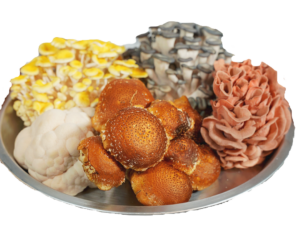
What to do with MUSHROOMS
Fresh Storage
It is best to store your mushrooms in a breathable paper bag on a shelf in the fridge, not in the vegetable drawer, as this will help them last longer. A paper bag provides a cool environment with good airflow that prevents them from sweating and going bad. At the same time, the bag creates a partially closed environment helping to prevent too much moisture loss. If they start to dry out and shrivel a little, you can still use them in soups and sauces, as they’ll rehydrate while cooking.
Freezing
You can freeze your mushrooms for use at a later date. They will last for up to 12 months in the freezer. You can freeze mushrooms whole or sliced and either raw, blanched or sauteed. Which method you choose will depend on the type of mushroom and how you plan on using them in the future. Most kinds are best cooked before freezing but some are fine raw like the maitake mushrooms. It’s best to freeze mushrooms as fresh as possible. Lay mushrooms out on a tray lined with parchment paper and slide the entire tray into the freezer. This will individually flash freeze them. Then you can take the frozen mushrooms out and put them in freezer bags to enjoy at a later date. Try to remove as much excess air from the bags as possible.
Drying
Traditionally people dried mushrooms by threading them onto a string and hanging them up to dry in a warm, airy spot. You can also dry mushrooms in a wicker basket, bamboo steamer or colander, that allow air circulation underneath the mushrooms. Put the mushrooms as close together as you can but not overlapping. Then, place the container in a warm, dry location with good air circulation, like a sunny windowsill.
Oven Drying
Place your mushrooms in a single layer on an ungreased baking sheet. Use the lowest setting possible (below 150°F/ 65.5°C) as excessive heat may destroy some of the beneficial compounds. Turn them over every hour until they are crisp and brittle. If you store mushrooms that still contain even a little moisture, they may rot or go moldy. Store your dried mushrooms in an airtight container in a cool, dark location.
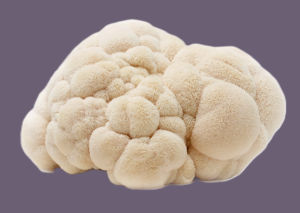
Lion’s Mane
Lion’s Mane is a unique mushroom used all over the world for culinary purposes and for health-supporting properties. This mushroom has a subtle, seafood-like flavour and a tender texture which makes it a great substitute in any seafood or crab recipe or great roasted on its own as a side dish. Having been used in traditional Chinese medicine for centuries, the lion’s mane mushroom is a medical powerhouse. Lion’s mane contains unique properties that may be able to protect the neurons and nerves in our bodies and assist in protecting the brain from cognitive decline associated with aging. Studies show that lion’s mane can increase the production of nerve growth factors that maintains the neural health in our brains. This awesome mushroom may be able to support short and long-term memory, enhancing cognitive function and regulate emotions. Lion’s mane promotes a healthy immune system and contains essential amino acids, antioxidant and anti-inflammatory properties.
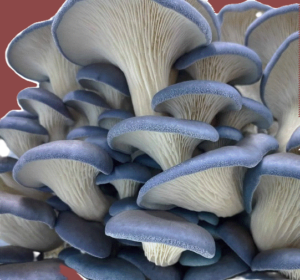
Blue Oyster
Blue oyster mushrooms are known for their striking blue to bluish-gray coloration which makes them a show stoper in stir-frying, sautéing dishes that have a short cook time. They have a soft and tender texture which pairs beautifully in light dishes like soups, risottos or pasta. These mushrooms have a mild, delicate flavour with a slightly sweet and anise-like aroma.
Blue oyster mushrooms are a low-calorie source of antioxidants, fiber, and protein. It also contains minerals such as potassium, phosphorus, iron, and zinc. Vitamins like niacin and pantothenic acid are also present in this mushroom. Antioxidants like polyphenol, beta carotene, and ascorbic acid in this mushroom remove harmful radicals from the body. Thus this mushroom boosts the immune system, prevents oxidative stress, and protects the body from various diseases. Intake of mushrooms also helps the body get rid of cholesterol and lipids, thus lowering cholesterol levels and preventing heart disease
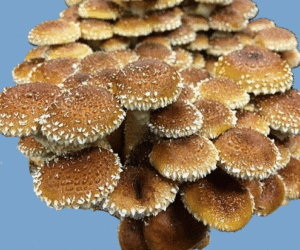
Chestnut
Chestnut mushrooms have a pronounced earthy flavour with subtle nutty undertones. They have a meatier texture and can be used in vegetarian and vegan recipes to provide a satisfying meaty texture and flavour. When the mushrooms are sautéed or roasted it enhances the overall flavour and brings out a mild sweetness. Chestnut mushrooms are a super-dense source of nutritious phytochemicals, vitamins, and minerals. They are rich in copper, selenium, protein, potassium, and vitamins B2, B3, and B5. They have a unique anti-tumor property that is especially important since it’s not usually found in other plant or animal species.
Another benefit of the chestnut mushroom is its anti-inflammatory properties. The cyclooxygenase enzymes COX-1 is the one regulating the body’s homeostatic functions, and COX-2 are responsible for the formation of prostaglandins that mediate pain and inflammation. They also help lower cholesterol as they contain very little fat and have high amounts of fiber.
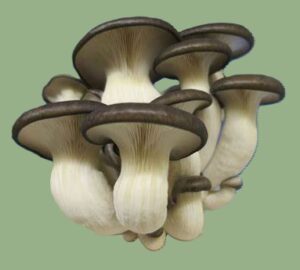
Black King Oyster
This stout and thick mushroom is pleasantly chewy and meaty and can be used from the top of the cap to the base of the stem.
IT has a wonderful nutty flavor with delicate and woodsy taste. They’re known for their impressive health-promoting properties and contain a variety of powerful compounds. In fact, they’ve been used in traditional medicine approaches for centuries. King oyster mushrooms provide a significant source of biotin, niacin, and riboflavin. It also contains B vitamins 1, 2, 3, and 6, and vitamin D, playing a role in the metabolism of food and contributing to the immune system. These mushrooms also contain moderate amounts of the minerals calcium, copper, iron, magnesium, manganese, phosphorus, selenium, and zinc. Additionally, they may help reduce blood sugar levels and cholesterol.
.
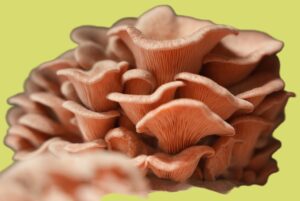
Pink Oyster
Pink oyster mushrooms, with their stunning ruffles and beautiful pink blush, taste delicious when tossed simply with olive oil, salt, and pepper and added to salads. The flavor of the pink oyster mushroom has been described as meaty and savory with a mild seafood taste. Its texture is both meaty and chewy. When fried until crispy, it resembles bacon or even ham. They are also good for your overall health. Pink oyster mushrooms have similar nutrient and health benefits to other varieties of oyster mushrooms. These benefits include lowering cholesterol and blood sugar, containing antioxidants, high in iron zinc potassium and selenium, high in vitamins B1, B3, B5 and B12, and reducing constipation. They have a high protein and fiber content and contain an antioxidant called ergothioneine, which may reduce plaque build-up in arteries and improve heart health.
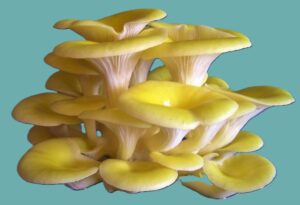
Yellow Oyster
Yellow Oyster mushrooms are among the most popular mushroom varieties due to their unique taste and texture. They have a sweet, earthy flavor and crunchy texture when fried, making them ideal for stir-fries, soups, and sauces. Similar to other oyster mushroom varieties they are high in protein 22.10% and fiber 20.78% and low in fat 1.32%. They are also a good source of potassium, other minerals, vitamin B and essential amino acids. These mushrooms help the body boost immunity, reduce inflammation and improve overall wellbeing. Other potential health benefits include preventing osteoporosis and arthritis, boosting vitamin D levels, maintaining blood pressure, lowering bad cholesterol levels, preventing anemia, providing protection against cancer, and boosting bone mineral density. They may also fight against bacteria, manage diabetes, and treat inflammation and cancer.
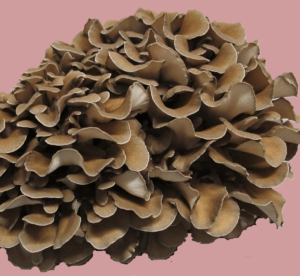
Maitake
Maitake mushrooms can be prepared by roasting, sautéing, marinating, pickling, or eating raw. They can be added to soups, stews, salads, casseroles, kabobs, omelets, or any foods you would enjoy having an earthy, savory flavor enhancement. Due to their meaty texture, they can be used in veggie burgers or other plant-based meat alternatives. These mushrooms are known as an adaptogen, with a reputation for treating both physical and mental ailments and balancing the body. Maitake mushrooms are an important ingredient in traditional Chinese and Japanese medicine, used for longevity and health. Like other mushroom varieties, maitake mushrooms are a nutrient-dense food low in calories, carbohydrates, and fat. They make a great plant-based source of vitamin D, B vitamins, choline, and zinc which are typically found more often in animal sources. They also provide other minerals such as phosphorus, magnesium, and potassium. Mushrooms, including maitakes, are high in several bioactive compounds such as antioxidants and glutathione which contribute to health. Studies also found that consuming one serving of mushrooms (defined as 70g) per day may increase life longevity.
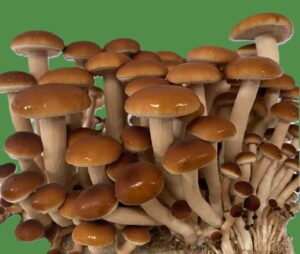
Pioppino
Pioppino mushrooms have an earthy, nutty flavor that’s slightly sweet with some peppery notes. Their smell is subtly floral, and their texture is firm and crunchy, often described as crispy. The unique sweet, nutty flavor of these mushrooms compliments many dishes. The nutrient density packed within Pioppino mushrooms enhances their dietary contribution. Though low in calories, they supply a rich blend of macronutrients, vitamins and minerals. Specific compounds support muscle growth, daily energy, digestion, skin health, oxygen circulation, immunity, wound repair, cardiovascular function, bone integrity and more. They are high in potassium which helps modulate key bodily processes related to heart health. Their wholesome nutrition empowers weight management and overall wellbeing. Compounds within these mushrooms may enhance immune function against infections. Potent antioxidants reduce oxidative damage linked to chronic disease. Anti-inflammatory effects help alleviate conditions like arthritis. Pioppinos additionally promote digestive health through beneficial gut bacteria and improved functioning. Early research also points to potential blood sugar regulating capabilities aiding diabetes management. .
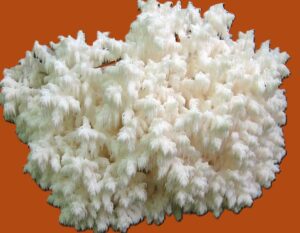
Combstooth
Combstooth mushroom has a mild, nutty flavor and a sweet, fragrant seafood-like undertone, similar to lobster or crab, making it a truly delicious delicacy. This mushroom is rich in protein, antioxidants, B vitamins, dietary fibers, and minerals, making them an excellent addition to any diet. It also has a lot of medicinal properties, including anti-inflammatory, anti-cancer, and antimicrobial properties. It can help boost immunity, regulate blood sugar levels, and reduce cholesterol. However, there has been little research into this mushroom powerhouse. Research is looking at factors that contribute to nerve growth as a potential medicine for cognitive performance, Alzheimer’s disease, digestive problems, and peripheral nerve regeneration.
